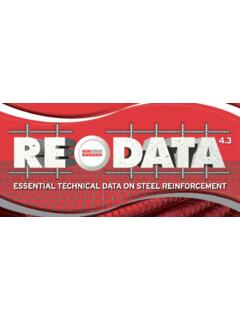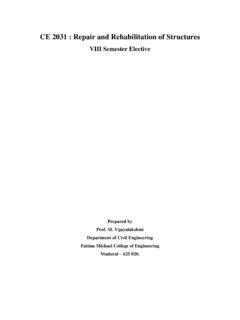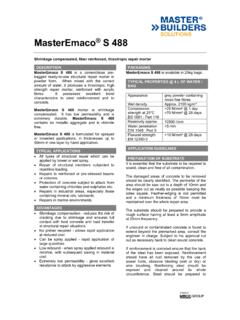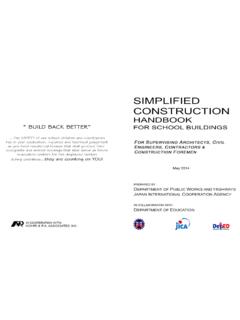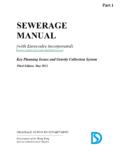Transcription of Pile Foundation Design[1] - ITD
1 Pile Foundation Design: A Student Guide Ascalew Abebe & Dr Ian GN Smith School of the Built Environment, Napier University, Edinburgh (Note: This Student Guide is intended as just that - a guide for students of civil engineering. Use it as you see fit, but please note that there is no technical support available to answer any questions about the guide!) PURPOSE OF THE GUIDE There are many texts on pile foundations. Generally, experience shows us that undergraduates find most of these texts complicated and difficult to understand. This guide has extracted the main points and puts together the whole process of pile Foundation design in a student friendly manner. The guide is presented in two versions: text-version (compendium from) and this web-version that can be accessed via internet or intranet and can be used as a supplementary self-assisting students guide.
2 STRUCTURE OF THE GUIDE Introduction to pile foundations Pile Foundation design Load on piles Single pile design Pile group design Installation-test-and factor of safety Pile installation methods Test piles Factors of safety Chapter 1 Introduction to pile foundations Pile foundations Historical Function of piles Classification of piles Classification of pile with respect to load transmission and functional behaviour End bearing piles Friction or cohesion piles Cohesion piles Friction piles Combination of friction piles and cohesion piles .Classification of pile with respect to type of material Timber piles Concrete pile Driven and cast in place Concrete piles Steel piles Composite piles Classification of pile with respect to effect on the soil Driven piles Bored piles Aide to classification of piles Advantages and disadvantages of different pile material Classification of piles - Review Chapter 2 Load on piles Introduction Pile arrangement Chapter 3 Load Distribution Pile foundations: vertical piles only Pile foundations.
3 Vertical and raking piles Symmetrically arranged vertical and raking piles Example on installation error Chapter 4 Load on Single Pile Introduction The behaviour of piles under load Geotechnical design methods The undrained load capacity (total stress approach) Drained load capacity (effective stress approach) Pile in sand Dynamic approach Chapter 5 Single Pile Design End bearing piles Friction piles Cohesion piles Steel piles Concrete piles Pre-cast concrete piles Timber piles (wood piles) Simplified method of predicting the bearing capacity of timber piles Chapter 6 Design of Pile Group Bearing capacity of pile groups Pile group in cohesive soil Pile groups in non-cohesive soil Pile groups in sand Chapter 7 Pile Spacing and Pile Arrangement Chapter 8 Pile Installation Methods Introduction Pile driving methods (displacement piles) Drop hammers Diesel hammers Pile driving by vibrating Boring methods (non-displacement piles) Continuous Flight Auger (CFA) Underreaming Chapter 9 Load Tests on Piles Introduction CRP (constant rate of penetration)
4 MLT, the maintained increment load test Chapter 10 Limit State Design Geotechnical category GC 1 Geotechnical category GC 2 Geotechnical category GC 3 Conditions classified as in Eurocode 7 The partial factors m, n, Rd Introduction to pile foundations Objectives: Texts dealing with geotechnical and ground engineering techniques classify piles in a number of ways. The objective of this unit is that in order to help the undergraduate student understand these classifications using materials extracted from several sources, this chapter gives an introduction to pile foundations. Pile foundations Pile foundations are the part of a structure used to carry and transfer the load of the structure to the bearing ground located at some depth below ground surface.
5 The main components of the Foundation are the pile cap and the piles. Piles are long and slender members which transfer the load to deeper soil or rock of high bearing capacity avoiding shallow soil of low bearing capacity The main types of materials used for piles are Wood, steel and concrete. Piles made from these materials are driven, drilled or jacked into the ground and connected to pile caps. Depending upon type of soil, pile material and load transmitting characteristic piles are classified accordingly. In the following chapter we learn about, classifications, functions and pros and cons of piles. Historical Pile foundations have been used as load carrying and load transferring systems for many years.
6 In the early days of civilisation[2], from the communication, defence or strategic point of view villages and towns were situated near to rivers and lakes. It was therefore important to strengthen the bearing ground with some form of piling. Timber piles were driven in to the ground by hand or holes were dug and filled with sand and stones. In 1740 Christoffoer Polhem invented pile driving equipment which resembled to days pile driving mechanism. Steel piles have been used since 1800 and concrete piles since about 1900. The industrial revolution brought about important changes to pile driving system through the invention of steam and diesel driven machines. More recently, the growing need for housing and construction has forced authorities and development agencies to exploit lands with poor soil characteristics.
7 This has led to the development and improved piles and pile driving systems. Today there are many advanced techniques of pile installation. Function of piles As with other types of foundations, the purpose of a pile foundations is: to transmit a Foundation load to a solid ground to resist vertical, lateral and uplift load A structure can be founded on piles if the soil immediately beneath its base does not have adequate bearing capacity. If the results of site investigation show that the shallow soil is unstable and weak or if the magnitude of the estimated settlement is not acceptable a pile Foundation may become considered. Further, a cost estimate may indicate that a pile Foundation may be cheaper than any other compared ground improvement costs.
8 In the cases of heavy constructions, it is likely that the bearing capacity of the shallow soil will not be satisfactory, and the construction should be built on pile foundations. Piles can also be used in normal ground conditions to resist horizontal loads. Piles are a convenient method of Foundation for works over water, such as jetties or bridge piers. Classification of piles Classification of pile with respect to load transmission and functional behaviour End bearing piles (point bearing piles) Friction piles (cohesion piles ) Combination of friction and cohesion piles End bearing piles These piles transfer their load on to a firm stratum located at a considerable depth below the base of the structure and they derive most of their carrying capacity from the penetration resistance of the soil at the toe of the pile (see figure ).
9 The pile behaves as an ordinary column and should be designed as such. Even in weak soil a pile will not fail by buckling and this effect need only be considered if part of the pile is unsupported, if it is in either air or water. Load is transmitted to the soil through friction or cohesion. But sometimes, the soil surrounding the pile may adhere to the surface of the pile and causes "Negative Skin Friction" on the pile. This, sometimes have considerable effect on the capacity of the pile. Negative skin friction is caused by the drainage of the ground water and consolidation of the soil. The founding depth of the pile is influenced by the results of the site investigate on and soil test. Friction or cohesion piles Carrying capacity is derived mainly from the adhesion or friction of the soil in contact with the shaft of the pile (see fig ).
10 Figure 1-1 End bearing piles Figure 1-2 Friction or cohesion pile Cohesion piles These piles transmit most of their load to the soil through skin friction. This process of driving such piles close to each other in groups greatly reduces the porosity and compressibility of the soil within and around the groups. Therefore piles of this category are some times called compaction piles. During the process of driving the pile into the ground, the soil becomes moulded and, as a result loses some of its strength. Therefore the pile is not able to transfer the exact amount of load which it is intended to immediately after it has been driven. Usually, the soil regains some of its strength three to five months after it has been driven.
